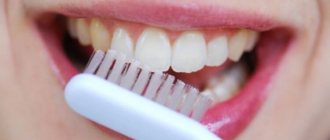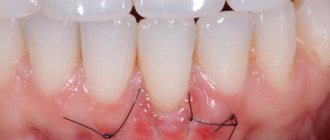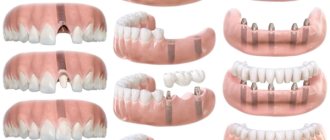Restoring a damaged tooth is a complex work aimed at preserving your dental unit and avoiding prosthetics or implantation. Modern dentistry offers a number of effective methods for treating a damaged tooth, even if only a two-millimeter root remains. In this material we will give answers to the most common questions regarding how to reliably restore a dental unit if it is more than half destroyed.
What teeth can be restored?
In dental practice, it is customary to consider those crowns that are missing more than 50% of their parts as a result of:
- carious lesion;
- mechanical injury;
- the presence of old fillings that do not collapse on their own, but caries develops underneath them;
- depulpation, against which the crown becomes fragile and changes color;
- increased abrasion of dentin, etc.
If you do not seek help from a dentist in time, restoring the unit will be problematic.
Causes of tooth decay
Molars and premolars are large and strong teeth that can withstand significant loads. As a rule, they suffer not from high blood pressure and mechanical damage, but from insufficient oral hygiene. Small particles of food accumulate in the grooves and pits on the chewing surface, which are a favorable environment for the growth of bacteria. If you neglect to brush your teeth, caries develops, which destroys hard tissue.
The risk of destruction of chewing teeth increases:
- bruxism,
- malocclusion,
- unbalanced diet,
- habits of gnawing nuts and biting hands,
- drinking hot food with cold drinks,
- genetic predisposition,
- deficiency of calcium, phosphorus and vitamin D in the body.
Is it possible to restore a damaged tooth?
Yes, you can. But everything will depend on the volume of the lost coronal part and the general condition of the oral cavity.
For restoration, modern dentists use the following two main methods:
- installation of pins (reinforcement) made of fiberglass or titanium;
- introduction of so-called stump inlays.
If more than 50% of the unit is destroyed, and the dentist has doubts that the crown restored with a stump or pin will not withstand the chewing load, a metal-ceramic crown is installed on the stump pin inlay. When restoring teeth, it is mandatory to clean and fill the canals to avoid the development of caries.
What is dental restoration and is it worth doing?
In modern society, beautiful and healthy teeth are one of the main signs of high social status! Therefore, if you do not want to look like a loser who does not have the means to take care of your appearance and health, then immediately run to the dentist and ask him to get your teeth in order. Remember that neither expensive clothes, nor a beautiful hairstyle, nor high-quality makeup can compensate for the unpleasant impression of your gap-toothed smile and crooked, broken, yellow teeth!
From the article you will learn what restoration is and what methods you can most effectively restore your teeth to get the best smile in the world.
What is dental restoration?
Unlike conventional treatment, dental restoration involves only the aesthetic restoration of a damaged tooth. Simply put, you will not have your teeth removed and replaced with dentures or implants. The doctor will simply give your crooked or damaged teeth a beautiful appearance. Therefore, dental restoration can be called a cosmetic rather than a medical procedure.
What are the advantages and disadvantages of aesthetic dental restoration?
Like any cosmetic procedure, dental restoration has its advantages and disadvantages, which you can find below.
Advantages of dental restoration:
- No severe pain. Almost all procedures associated with dental restoration do not cause severe pain to the patient. Although, people with hypersensitive teeth may experience some discomfort.
- Speed of the process. In some cases, the restoration of one or more teeth requires only one visit to the dentist. Even if the restoration process requires several procedures, it lasts much less time than the process of dental prosthetics.
- Acceptable price. Almost all procedures for dental restoration are much cheaper than procedures for installing implants. But it is worth considering that the price largely depends on the level of the clinic and the city in which it is located.
Disadvantages of dental restoration:
- Lack of treatment. Restoration can improve the appearance of a tooth, but cannot cure it. For example, if there is inflammation in a tooth, it may remain after the restoration and cause pain to the patient. In addition, in some cases, it is better to remove the diseased tooth and install an implant, rather than mask it with restoration.
- Not very long guarantees. Restored teeth may become dull, change color and become damaged, especially if the patient is addicted to cigarettes, alcohol, sweets and eating hard foods. For this reason, dentists try not to give long-term guarantees on restored teeth.
For what defects should dental restoration be done?
As you already understand, dental restoration is recommended only if there are defects that do not require comprehensive treatment. Below you can find a list of these defects:
- The presence of caries on the surface of the teeth. After eliminating this defect, it is recommended to intensify dental care and monitor the acid-base balance in the oral cavity. Otherwise, caries will reappear on the teeth very quickly.
- Large gaps between the upper and lower teeth. After removing the cracks, try not to eat too hard or sticky foods.
- Chips on teeth. In this case, restoration is done only if more than fifty percent of the damaged tooth is preserved. In case of more significant destruction, it is recommended to remove the tooth and install a prosthesis or implant.
- Yellowing of teeth. Whitened teeth will remain white longer if you stop smoking and drinking coffee.
- Damage to enamel. After restoring the enamel, it is better to avoid drinking too hot and cold drinks.
Two main methods of dental restoration
Dental restoration is carried out in two ways, the features of which you can find out below:
- Method one: restoration using photopolymers and vitreous cement. With this method, the doctor eliminates defects using special filling solutions. Using photopolymers and vitreous cement, the dentist can build up teeth, fill gaps and renew enamel. Restoration using this method does not take much time and can be completed in one procedure.
- Method two: restoration using individual veneers. This is a longer method of dental restoration, since the doctor takes time to take an impression of the patient’s teeth and make veneers from ceramic or plastic. Veneers are placed on the outer part of the teeth and mask all their imperfections. Please note that veneers are really just a disguise and not a solution to the problem. Therefore, in case of severe defects, it is better to resort to treatment and prosthetics.
At the end of the article, I would like to advise you to lead a healthy lifestyle and get rid of all bad habits, since they are often the cause of dental defects!
Tags: dental restoration, dental restoration methods, dental restoration using photopolymers and vitreous cement, dental restoration using individual veneers, Mosrentgen dental restoration, Mosrentgen dental restoration methods
Light filling on a pin – what are the advantages of the method?
A post filling is considered a reliable replacement material when a dentist is restoring a fractured unit. A titanium or fiberglass pin is inserted into the root canal, after which the coronal part is restored with a composite material. Among the disadvantages of the method is the potential risk of root fracture, since the pin fails under pressure, as well as shrinkage of the filling and the development of secondary caries under it.
Unfortunately, teeth restored in this way do not last forever. After 3–5 years, the dentist will have to change the filling or, due to global destruction of the crown, perform prosthetics/implantation.
Price
In ILATAN clinics you can restore one tooth with a filling for 6,950 rubles. The price includes: inspection, shade selection, preparation, bonding, application of composite material, anatomical shaping, finishing. Working with the central tooth will cost slightly more - 7,795 rubles.
Tooth restoration with an inlay ─ from 8,400 rubles, EMax-inlay or from zirconium dioxide ─ about 30,000 rubles. We offer a promotional offer to consider metal-free inlays with individual coloring for RUB 14,000. All questions and current prices will be answered by phone.
How to restore a damaged tooth?
Treatment of a damaged tooth involves the following steps:
- examination by a dentist and assessment of further “future” damaged teeth;
- restoration of the stump area using a pin or inlay. The dentist treats the canals, strengthens the unit from the inside, thereby providing reliable support for the filling;
- The crown is built up using a composite material. If the work is done efficiently, the tooth can be visually almost indistinguishable from a natural one. The dentist repeats the shape, color and even transparency.
Doctor's recommendations
You cannot turn a blind eye to the onset of tooth decay; you need to identify the cause and eliminate it. If this comes from the state of health, the functioning of the endocrine system, the immune system, it is worth undergoing examination and treatment by a specialist. Sometimes permanent damage to the enamel and gums is a signal that something is wrong. The body tries to attract attention to itself in this way. Therefore, having gotten rid of the source of the problems, you can safely restore the enamel on your teeth and the teeth themselves. In today's world, the patient has a choice of how to treat and what to restore. We, in turn, offer our qualified services in order to look at this world with a beautiful smile.
Delete or Treat?
There are two approaches to the treatment of periodontitis:
- Remove the problematic tooth and place a crown on an implant in its place. Such treatment, according to doctors, is faster and easier, and the result is more predictable.
- Doctors who recommend fighting for a tooth insist that your own tooth is always better, and it’s never too late to get an implant. They suggest using “every option” to save the tooth.
However, dentists do not always clearly explain that treating a “problem tooth” will require significant time and financial costs, but may not lead to the desired results. If efforts to save the tooth turn out to be in vain, then the cost of “prosthetics on an implant” will have to be added to the cost of “treatment”, since the absence of even one tooth in the jaw affects the position of neighboring teeth.
The choice of “treat” or “remove” is not very simple, since it depends on many factors. Let's figure out what guides a dentist when offering his treatment plan.
What to do if the root remains in the gum?
Now you know why you should not leave the roots of decayed teeth in the gums, but sometimes situations arise when the presence of roots is not obvious: the patient is not bothered by anything, and he thinks that there is nothing left in the gums. This happens, for example, with an illiterate tooth extraction: as a result of the actions of an unqualified employee, the root or part of it remains in the soft tissues, and they find out about it too late. If you suspect that a tooth root remains in the gum, contact specialists who will conduct a thorough diagnosis. Signs indicating the possible presence of a tooth root include:
- frequent and significant pain even after a long period of time after visiting the surgeon,
- redness of the mucous membrane, bleeding,
- pulsation and painful sensations when pressing, chewing,
- heat.
If the answer to the question “can a decayed tooth be cured” is negative, it is removed, like the root. When it turns out that the root of the tooth, for one reason or another, remains in the gum, and its removal is required, the procedure is carried out as follows.
- First, the attending physician gives an injection of an anesthetic, which is necessary to ensure that the operation is completely painless.
- Then, after about 5-10 minutes, when the remedy has taken effect, the doctor makes an incision in the gum, and in severe cases, also makes a hole in the bone tissue using a drill.
- Having firmly grasped the root with forceps, the doctor removes it from the hole. Because some teeth may have multiple roots, they may require root division. This is done using a traditional burr or a modern method - ultrasound.
- Then the place that was subjected to such a traumatic procedure is treated with an antiseptic and a composition that accelerates healing. If there are incisions, stitches are applied.
If you are bothered by frequent pain in your jaw, although there are no apparent reasons for this, you should not hope that the pain will go away on its own. Contact qualified dentists at a specialized dental clinic, whose staff have many years of experience and will be able to find out the cause of the ailment. They will determine whether it is possible to restore a damaged tooth if the cause of the pain lies in it, and will do everything possible to save and restore the tooth, as well as quickly and painlessly remove it if there is no other option.
"AlfaDent" - we remove the problem at the root.
What happens if you don’t see a doctor in a timely manner?
If, after much thought about what to do with a decayed tooth, you decide to leave everything as it is, you are seriously risking your health. Damage to the gums can affect neighboring teeth, and pathological changes in soft tissues will not take long to occur. Many people, without thinking about the consequences of their decision, walk around with a tooth destroyed at the very base, believing that they are in no danger: after all, at first glance, there are no changes in their well-being. However, in some cases they may be invisible only at first. If the crown part of the tooth is destroyed, changes can be observed with the naked eye. However, in the case of a root this is not possible. Damage to it can lead to infections. As a result, at a minimum, a person will experience constant bad breath, which is difficult to get rid of, and in more severe cases, plaque and tartar may form, which will gradually spread to neighboring teeth.
If there is an infection, the condition of not only the tooth root, but also the entire oral cavity worsens. Which can negatively affect the state of the microflora of the digestive system as a whole, since pathogenic organisms will be swallowed along with saliva. The immune system will have to expend considerable effort to maintain normal health. In the long term, it is possible to develop sinusitis, inflammation of bone tissue and other serious diseases.
What to do with a thin protective shell
In case of damage or genetic predisposition, there is no need to be upset. We will have to strengthen control and care of the oral cavity in order to prevent the development of pathological processes and long-term treatment, but there is nothing terrible about it. Follow a few basic principles that will help keep your smile beautiful and your teeth healthy:
- stop eating solid foods;
- visit the dentist at least once every six months;
- carry out professional fluoridation;
- use remineralizing agents twice a day as prescribed by your doctor;
- stick to a diet, eat more vegetables, fruits and healthy foods.
To prolong the beauty of a smile, it is enough to increase attention and care. This will not take much time, but will prevent further tooth thinning and damage.










